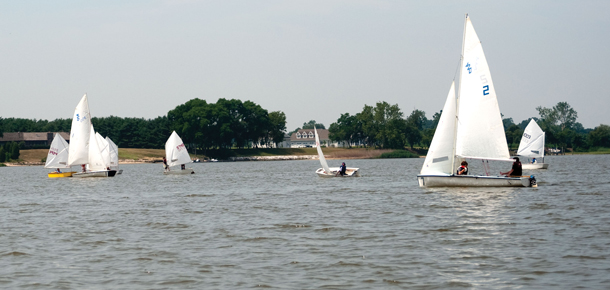Knauss legislative fellowships in Congress help build careers — and they're fun and educational. See our video and fact sheet for details.
Chesapeake Bay Facts and Figures

The Chesapeake Bay has held a central spot in the culture, history, and economics of Maryland for centuries. For many people, the Chesapeake conjures up images of lazy days dropping chicken necks off a dock to catch blue crabs. Or boating down the Patuxent River or one of the Bay’s many other tributaries. Below are some facts and figures about the Chesapeake Bay and its watershed to illustrate how these resources contribute to Maryland’s residents and visitors.
How the Bay Benefits Marylanders
- Rivers, streams, and aquifers supply clean drinking water to millions of state residents.
- Crab, striped bass, oyster, and other fisheries support the livelihood of commercial watermen.
- Marshes buffer shorelines against storms and flooding.
- Wetlands, forests, and shorelines provide habitats for diverse plant and animal species.
- Beaches and other waterfront attractions draw tourists to Maryland.
More things to know about the Chesapeake, the nation’s largest estuary
- While just two states, Maryland and Virginia, border the Chesapeake Bay, the Bay’s watershed stretches much further. The watershed — the area that drains into the Bay — covers parts of six states: Delaware, Maryland, New York, Pennsylvania, Virginia, and West Virginia. Plus the District of Columbia.
- The Bay extends from Havre de Grace, Maryland, south to Virginia Beach, Virginia. That’s almost 200 miles.
- If you include the tidal portions of the Bay’s tributaries, the estuary covers around 4,480 square miles.
- It loops around 11,684 miles of shoreline.
- The Bay holds more than 18-trillion gallons of water — that’s about 27 million Olympic-sized swimming pools worth of water.
- The Bay would hold a lot more water, except it’s usually very shallow. It’s average depth is only about 21 feet, although it dips down to 174 feet at its deepest spot — off of Bloody Point on Kent Island, Maryland.
- And where does all that water come from? Try the 150 or so rivers and streams that dump into the Chesapeake. Also the Atlantic Ocean, which flushes salt water in through the mouth of the Bay.
- The three biggest of the Bay’s tributaries are the Susquehanna (Pennsylvania), Potomac (Maryland), and James (Virginia) rivers. But there are many more storied tributaries, too, including the Patuxent, Choptank, and Pocomoke rivers in Maryland.
- More than 17 million people lived in the Bay watershed in 2010.
- But it’s home to a lot more plants and animals. At least 2,700 species live in the estuary itself.
- Many animals, including fish, bivalves, and shellfish, are caught for commercial purposes on the Chesapeake — totaling around 500 million pounds of seafood every year.
This list was adapted from one published by the U.S. EPA Chesapeake Bay Program.




